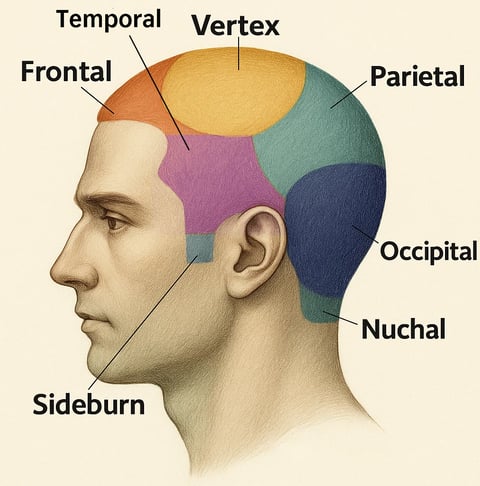Understanding Androgenetic Alopecia (AGA)
Hair loss can seriously impact confidence and androgenetic alopecia is the number one cause of hairloss in men. Often blamed on stress or vitamins defficiencies, it’s actually driven by hormones, genetics, and the gradual aging of scalp cells. In this article, we’ll break down what really causes androgenetic alopecia and how to help fight it.
4/28/20255 min read
1. What is Androgenetic Alopecia?
Androgenetic alopecia (AGA) is the most common cause of hair loss in men. It occurs when hair follicles gradually shrink due to increased sensitivity to the hormone DHT (dihydrotestosterone), leading to thinner, shorter, and weaker hair over time.
In men, AGA typically follows a specific pattern:
It often starts with a receding hairline at the temples,
Then progresses to thinning at the crown (the top of the head),
These areas may eventually merge, leading to extensive balding.
Unlike an external disease such as an infection or a skin condition, AGA is an internal biological process driven by hormones, genetic predisposition, and cellular aging.
Even if some follicles stop producing visible hair, they are not destroyed the follicle remains dormant and can, under the right conditions, potentially be reactivated.
2. Why is it called "androgenetic"?
The name "androgenetic" combines two key elements:
Androgen refers to male sex hormones like DHT and testosterone,
Genetic highlights the hereditary aspect, as sensitivity to these hormones is largely inherited from one’s parents.
This type of hair loss is triggered by hormonal activity, worsened by genetic susceptibility, and further accelerated by the aging process.
3. How does it actually start?
Hair miniaturization is driven by a hormone called dihydrotestosterone (DHT), which is produced from testosterone through the action of the enzyme 5-alpha reductase.
DHT binds to androgen receptors located in the cells of the hair follicle, especially in the dermal papilla, the structure at the base of the follicle that controls hair growth. This binding triggers genetic signals inside the follicle that:
Shorten the growth phase (called the anagen phase),
Slow down hair production,
And progressively shrink the follicle over time.
Although the biological process of miniaturization can begin as early as puberty, when androgen levels (including DHT) significantly rise, it often remains silent and invisible for many years.
In most cases, the first noticeable signs of hair thinning or recession appear in a man's late twenties or thirties.
This delayed onset happens because, over time, androgen receptors in the hair follicles become increasingly sensitive to DHT as part of the natural aging process. As sensitivity grows, the follicles weaken, and hair becomes progressively thinner, shorter, and more fragile.
While for some individuals the process remains slow and subtle for decades, others may experience more rapid progression. Each person's response to androgenetic alopecia is unique, making it impossible to predict exactly how fast or severely it will develop.
4. Why does hair only fall out in certain areas?
The scalp is divided into different zones based on how sensitive the hair follicles are to DHT.
The back and sides of the scalp (known as the occipital and parietal regions) are naturally more resistant to DHT.
Hair follicles in these areas express fewer androgen receptors, and their genetic programming makes them less reactive to hormonal signals that cause miniaturization.
As a result, DHT has little or no damaging effect here, and these follicles continue to produce thick, terminal hair even when androgenetic alopecia progresses.The frontal hairline, temples (temporal), and crown (vertex), on the other hand, are highly sensitive to DHT.
Follicles in these zones have a higher density of androgen receptors and are genetically programmed to react strongly to DHT binding.
When DHT attaches to their receptors, it triggers internal changes that shorten the growth phase, reduce hair shaft diameter, and shrink the follicle over time.
This uneven distribution of DHT sensitivity explains why androgenetic alopecia follows this distinct and predictable pattern. This is also why hair from the occipital area is commonly used in hair transplant surgeries because it retains its DHT resistance even when moved to DHT-sensitive areas.




5. Are there other causes besides hormones?
Yes research shows that other key factors also contribute to androgenetic alopecia:
Aging of scalp cells
As we age, the cells that support hair growth, become senescent. Senescent cells lose their ability to maintain healthy hair follicle function. They provide less support for hair growth and become more vulnerable to damage from external stressors, accelerating follicle weakening and miniaturization.
Inflammation and oxidative stress
Even without visible redness, AGA scalps often show signs of chronic low-grade inflammation.
Inflammatory molecules and free radicals (unstable molecules that damage cells) attack the hair follicles over time. This persistent cellular damage weakens the follicles further and speeds up the progression of hair loss.
Disruption of a vital growth pathway, the WNT pathway
For hair follicles to enter and maintain the growth phase (anagen), the dermal papilla relies on a crucial signaling system called the WNT/β-catenin pathway. In androgenetic alopecia, DHT and other genes suppresses this pathway, impairing the follicle’s ability to properly restart new growth cycles. Without sufficient WNT activation, follicles cannot regenerate effectively, and no hair growth occurs.
6. Can androgenetic alopecia be stopped?
Good news, yes to some extent. While there is currently no complete cure for androgenetic alopecia, the good news is that it can often be slowed down, stabilized, and in some cases, partially reversed, especially if treated early. Here are the main approaches available today:
Block DHT production or Androgen Receptors
Finasteride or Dutasteride : Reducing the amount of DHT produced in the body especially in the dermal papilla can help slow or even partially reverse the progression of hair loss. DHT is produced from testosterone by an enzyme called 5-alpha reductase and medications like finasteride (which inhibits type II 5-alpha reductase) and dutasteride (which inhibits both type I and II) can strongly lower DHT levels, reducing the hormonal attack on hair follicles and giving them a better chance to recover and continue growing healthy hair.
RU58841 : Even if DHT remains, hair loss can be slowed by preventing DHT from binding to its target: the androgen receptor inside dermal papilla cells. One way to achieve this is by using topical anti-androgens like RU58841, a molecule that acts locally by blocking androgen receptors in the scalp. By preventing DHT from activating these receptors, RU58841 can protect the follicles even without significantly reducing systemic DHT levels.
By combining both strategies, lowering DHT production and blocking its action at the receptor level, it’s possible to build a much stronger defense against androgenetic alopecia.
Effect: Slows down hair loss, helps maintain existing hair, and can promote some regrowth, especially in the early stages.
Stimulate Hair Growth
Beyond blocking androgens, directly stimulating follicles can promote thicker, longer-lasting hair.
Minoxidil : Originally developed as a blood pressure medication, it works by widening blood vessels and opening potassium channels, which may improve follicle size and extend the growth phase (anagen phase).
Research suggests that minoxidil influence intracellular calcium levels. Dysregulation in calcium signaling have been linked to follicle aging, mitochondrial dysfunction, and impaired hair growth. Moreover, calcium signaling plays a crucial role in activating the WNT/β-catenin pathway, a key driver of hair follicle regeneration and growth.Microneedling involves using a device covered with tiny needles to create controlled micro-injuries in the scalp. These tiny wounds trigger the skin’s natural healing response, stimulates the proliferation of stem cells around the hair bulb and the production of growth factors and activating important regenerative pathways, including the WNT/β-catenin pathway, which is essential for hair follicle regeneration.
2-Deoxy-D-ribose (2dDR) is a sugar with surprising biological effects. In endothelial cells (which line blood vessels), 2dDR promotes angiogenesis. In healthy contexts, angiogenesis ensures that tissues receive enough oxygen, nutrients, and growth factors. In the scalp, for example, strong angiogenesis around hair follicles supports better follicle function and prolonged hair growth phases.
Recent research has shown that 2-deoxy-D-ribose (2dDR) can significantly enhance hair regrowth on mice. Treated mice developed:Longer and thicker hair follicles,
Increased follicle density,
Enhanced pigmentation,
And a greater number of blood vessels supporting the follicles.
The effects observed were comparable to those achieved with minoxidil. Beyond its pro-angiogenic properties, 2dDR also demonstrated a protective effect against cellular stress, helping cells survive under low-oxygen conditions. This suggests that 2dDR may not only improve blood supply but also enhance the resilience of hair follicle cells to age-related damage.
Effect: Encourages hair follicles to produce thicker, stronger hair, but can not prevent miniaturization caused by androgens.
